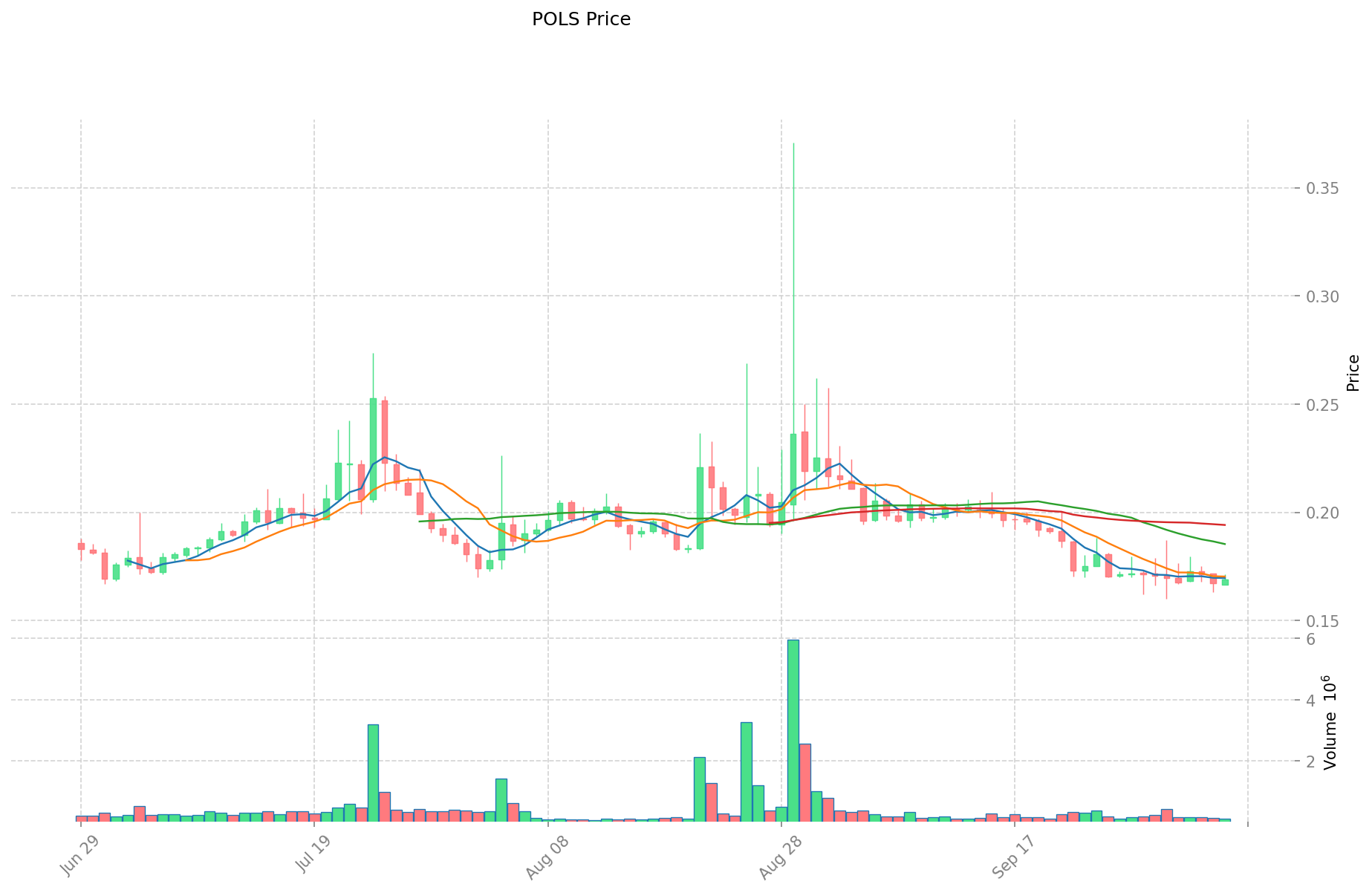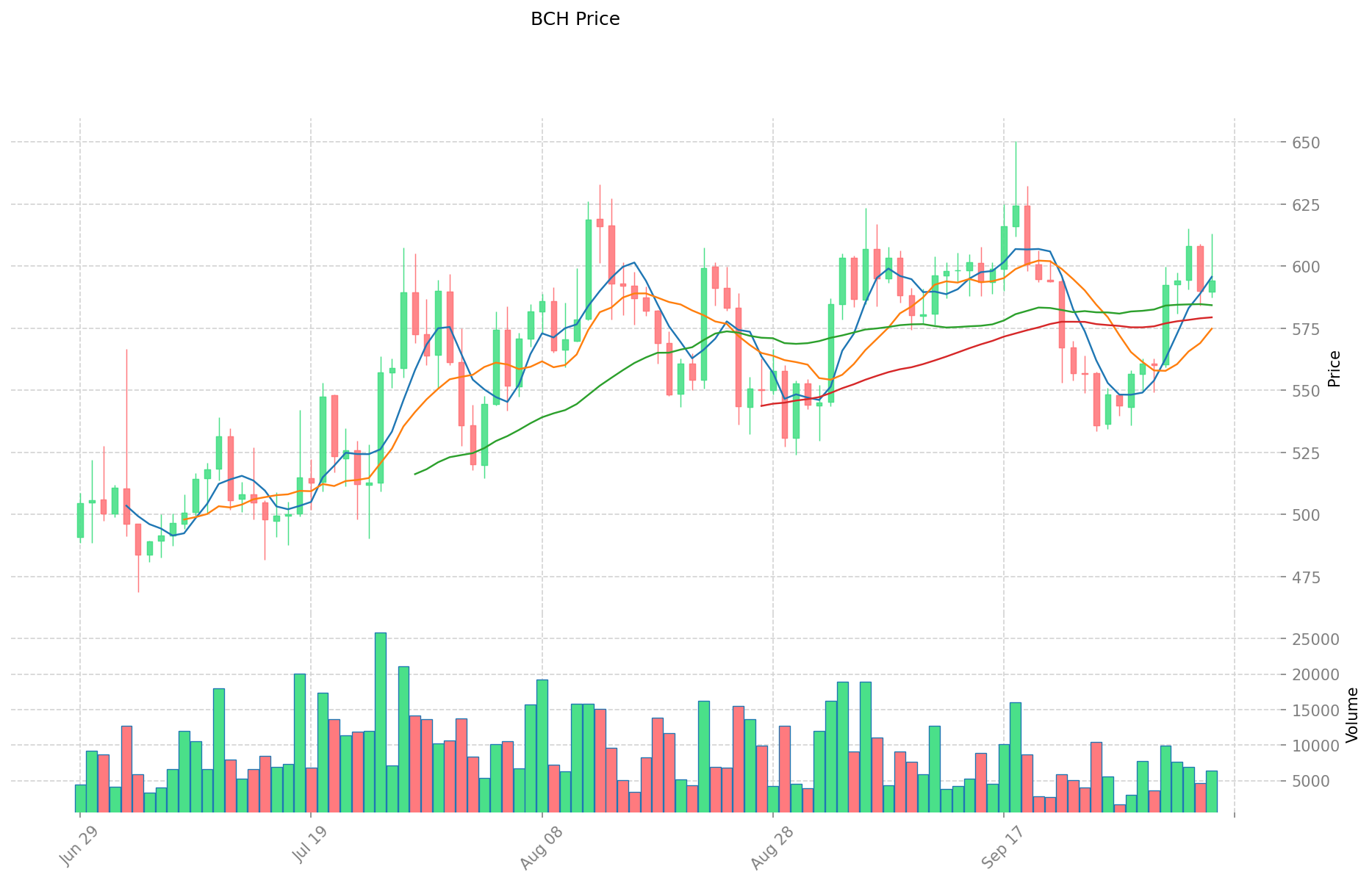POLS ve BCH: İki Yükselen Kripto Paranın İşlem Desenleri ile Piyasa Performansının Analizi


Giriş: POLS ile BCH Yatırımı Karşılaştırması
Kripto para piyasasında Polkastarter (POLS) ile Bitcoin Cash (BCH) karşılaştırması, yatırımcılar tarafından sıkça değerlendirilen bir konudur. Bu iki kripto para, hem piyasa değeri sıralamaları, kullanım alanları ve fiyat performanslarıyla büyük farklılıklar gösterir hem de kripto dünyasında farklı yaklaşımları temsil eder.
Polkastarter (POLS): 2020’de piyasaya sürülmesinden itibaren IDO’ların başlatılması ve yönetilmesindeki başarısıyla piyasa tarafından kabul görmüştür.
Bitcoin Cash (BCH): 2017’de piyasaya çıkan BCH, hızlı ve düşük maliyetli bir ödeme sistemi olarak öne çıkmış, küresel ölçekte en yüksek işlem hacmi ve piyasa değerine sahip kripto paralardan biri olmuştur.
Bu yazıda POLS ve BCH yatırımlarının değeri; tarihsel fiyat eğilimleri, arz mekanizmaları, kurumsal benimseme, teknik ekosistem ve gelecek tahminleri temelinde kapsamlı şekilde analiz edilip yatırımcıların en çok merak ettiği şu soruya yanıt aranacaktır:
"Şu anda hangisi daha avantajlı bir yatırım?"
I. Fiyat Geçmişi Karşılaştırması ve Güncel Piyasa Durumu
POLS (Coin A) ve BCH (Coin B) Tarihsel Fiyat Hareketleri
- 2021: POLS, IDO piyasasındaki büyüme ile 7,51 $ ile tüm zamanların en yüksek seviyesine çıktı.
- 2017: BCH, Bitcoin’in sert çatallanması (hard fork) ile ortaya çıktı ve ilk fiyatı yaklaşık 555,89 $ oldu.
- Karşılaştırmalı analiz: 2022 ayı piyasasında POLS, zirveden 0,116476 $’a gerilerken; BCH, 3.785,82 $’lık zirveden 76,93 $’a indi.
Güncel Piyasa Durumu (06 Ekim 2025)
- POLS güncel fiyatı: 0,1691 $
- BCH güncel fiyatı: 593,09 $
- 24 saatlik işlem hacmi: POLS için 21.183.309 $ ve BCH için 3.864.011.335 $
- Piyasa Duyarlılık Endeksi (Korku ve Açgözlülük Endeksi): 74 (Açgözlülük)
Canlı fiyatlar için aşağıdaki bağlantıları kullanabilirsiniz:
- POLS güncel fiyatı için Piyasa Fiyatı
- BCH güncel fiyatı için Piyasa Fiyatı


POLS ve BCH Yatırım Değeri Karşılaştırmalı Analizi
I. POLS ve BCH Yatırım Değerini Etkileyen Temel Faktörler
Arz Mekanizmaları (Tokenomics)
- POLS: Piyasa dinamikleri ve makine öğrenimi algoritmalarıyla çalışan algoritmik işlem mekanizmaları
- BCH: Bitcoin’e benzer sabit arz, ödeme işlevine odaklanan yapı
- 📌 Tarihsel Model: BCH, klasik kripto para arzına bağlı kalırken; POLS, algoritmik işlem sinyallerine ve piyasa analizlerine daha hızlı tepki verir.
Kurumsal Benimseme ve Piyasa Uygulamaları
- Kurumsal Portföyler: BCH, Bitcoin’in bir fork’u olarak daha fazla tanınmakta ve ödeme alanında köklü kullanıma sahiptir
- Kurumsal Kullanım: BCH, ödeme süreçlerinde ve işlem verimliliğinde avantaj sunarken; POLS, daha özel alım-satım işlevlerine hizmet eder
- Düzenleyici Bakış: BCH, büyük kripto paralarla benzer küresel düzenlemelere tabi olup farklı ülkelerde farklı düzeyde kabul görmektedir
Teknik Gelişim ve Ekosistem
- POLS Teknik Özellikleri: Destek seviyeleri, işlem hacimleri ve piyasa dinamiklerini analiz eden algoritmalar ile en uygun alım-satım fırsatlarını belirler
- BCH Teknik Gelişimi: İşlem kapasitesi ve hızına odaklanan blockchain tabanlı ödeme çözümleri
- Ekosistem Karşılaştırması: BCH’nin ödeme altyapısı daha gelişmişken; POLS, daha spesifik alım-satım ve yatırım işlevleri sunar
Makroekonomik Faktörler ve Piyasa Döngüleri
- Enflasyon Performansı: BCH, Bitcoin’e benzer şekilde enflasyona karşı koruma potansiyeli taşır
- Para Politikası Etkisi: Her iki varlık da ABD Merkez Bankası’nın politikalarından etkilenir ve faiz döngüleri ile kripto fiyatları arasında negatif korelasyon görülür
- Jeopolitik Faktörler: BCH, belirsiz jeopolitik ortamda sınır ötesi ödeme avantajı ile öne çıkar
II. Değerleme Modelleri ve Yatırım Kriterleri
BCH İçin Uygun Bitcoin Tabanlı Değerleme Modelleri
- Stock-to-Flow Modeli: Kıtlık ve arz büyüme hızını değerlendirir
- Metcalfe Yasası: Kullanıcı tabanı ve işlem aktivitesi ile ağ değerini hesaplar
- Madencilik Maliyet Analizi: Elektrik dahil üretim maliyetlerini göz önünde bulundurur
Uzun Vadeli Yatırım Görünümü
- BCH’nin değeri esas olarak ödeme aracı olması ve blockchain teknolojisi uygulamalarından kaynaklanır. POLS yatırımı ise piyasa dinamiklerine, algoritma performansına ve özel kullanım alanlarına bağlıdır. Her iki varlık, genel kripto piyasa döngüleri ve makroekonomik şartlar çerçevesinde değerlendirilir.
III. 2025-2030 Fiyat Tahmini: POLS ile BCH
Kısa Vadeli Tahmin (2025)
- POLS: Muhafazakâr 0,145684 - 0,1694 $ | İyimser 0,1694 - 0,181258 $
- BCH: Muhafazakâr 429,084 - 595,95 $ | İyimser 595,95 - 774,735 $
Orta Vadeli Tahmin (2027)
- POLS büyüme dönemine girebilir. Tahmini fiyat aralığı 0,1847091015 - 0,24269916825 $’tır.
- BCH boğa piyasasına girebilir. Tahmini fiyat aralığı 731,397516 - 1.009,646571 $’tır.
- Kilit faktörler arasında kurumsal sermaye girişleri, ETF ve ekosistem gelişimi yer alır.
Uzun Vadeli Tahmin (2030)
- POLS: Temel senaryo 0,327496485717843 - 0,471594939433695 $ | İyimser senaryo 0,471594939433695 $+
- BCH: Temel senaryo 1.066,45429556745 - 1.279,74515468094 $ | İyimser senaryo 1.279,74515468094 $+
Yasal Uyarı: Buradaki bilgiler yalnızca bilgilendirme amaçlıdır, yatırım tavsiyesi değildir. Kripto piyasaları son derece dalgalı ve öngörülemezdir. Yatırım kararlarınızda mutlaka kendi araştırmanızı yapınız.
POLS:
| Yıl | Tahmini En Yüksek Fiyat | Tahmini Ortalama Fiyat | Tahmini En Düşük Fiyat | Yüzde Değişim |
|---|---|---|---|---|
| 2025 | 0,181258 | 0,1694 | 0,145684 | 0 |
| 2026 | 0,25422705 | 0,175329 | 0,12097701 | 3 |
| 2027 | 0,24269916825 | 0,214778025 | 0,1847091015 | 27 |
| 2028 | 0,34082050897125 | 0,228738596625 | 0,16697917553625 | 35 |
| 2029 | 0,370213418637562 | 0,284779552798125 | 0,145237571927043 | 68 |
| 2030 | 0,471594939433695 | 0,327496485717843 | 0,176848102287635 | 93 |
BCH:
| Yıl | Tahmini En Yüksek Fiyat | Tahmini Ortalama Fiyat | Tahmini En Düşük Fiyat | Yüzde Değişim |
|---|---|---|---|---|
| 2025 | 774,735 | 595,95 | 429,084 | 0 |
| 2026 | 904,6521 | 685,3425 | 657,9288 | 15 |
| 2027 | 1.009,646571 | 794,9973 | 731,397516 | 34 |
| 2028 | 1.010,60056776 | 902,3219355 | 631,62535485 | 52 |
| 2029 | 1.176,4473395049 | 956,46125163 | 918,2028015648 | 61 |
| 2030 | 1.279,74515468094 | 1.066,45429556745 | 757,1825498528895 | 79 |
IV. Yatırım Stratejisi Karşılaştırması: POLS ile BCH
Uzun Vadeli ve Kısa Vadeli Yatırım Stratejileri
- POLS: Alım-satım algoritmaları ve özel piyasa fonksiyonlarına odaklanan yatırımcılar için uygundur
- BCH: Ödeme işlevi ve blockchain uygulamaları arayan yatırımcılar için uygundur
Risk Yönetimi ve Varlık Dağılımı
- Temkinli yatırımcılar: POLS %20, BCH %80
- Agresif yatırımcılar: POLS %40, BCH %60
- Koruma araçları: Stablecoin, opsiyonlar, çoklu para portföyleri
V. Potansiyel Risk Karşılaştırması
Piyasa Riskleri
- POLS: Piyasa dinamikleri ve alım-satım fonksiyonlarının özelleşmiş yapısı nedeniyle yüksek oynaklık
- BCH: Kripto para piyasası genel eğilimleri ve Bitcoin fiyat hareketlerinden etkilenebilir
Teknik Riskler
- POLS: Algoritmik işlem riskleri ve platform kararlılığı
- BCH: Madencilikte merkezileşme ve olası güvenlik açıkları
Düzenleyici Riskler
- Küresel düzenleyici politikalar her iki varlığı farklı etkileyebilir; BCH, ödeme odaklı olduğu için daha fazla denetime maruz kalabilir
VI. Sonuç: Hangisi Daha Avantajlı?
📌 Yatırım Değeri Özeti:
- POLS avantajları: Özel alım-satım fonksiyonları, algoritmik işlem potansiyeli
- BCH avantajları: Yerleşik ödeme işlevi, büyük piyasa değeri, yaygın benimseme
✅ Yatırım Önerisi:
- Yeni yatırımcılar: BCH’nin köklü piyasa konumundan dolayı muhafazakâr dağılımı tercih edebilir
- Tecrübeli yatırımcılar: Her iki varlık ile dengeli portföy oluşturarak, POLS ile potansiyel yüksek getiri elde edebilir
- Kurumsal yatırımcılar: Yatırım hedeflerine göre stratejik dağılım; BCH, likit ve yerleşik varlık olarak öne çıkabilir
⚠️ Risk Uyarısı: Kripto para piyasası yüksek derecede oynaktır. Bu makale yatırım tavsiyesi değildir.
Sıkça Sorulan Sorular
S1: POLS ile BCH arasındaki temel farklar nelerdir? C: POLS, algoritmik alım-satım ve IDO yönetimine odaklanır; BCH ise temel olarak ödeme odaklıdır. POLS’ın piyasa değeri küçük ve oynaklığı yüksektir; BCH ise geniş benimsenme ve yüksek işlem hacmine sahiptir.
S2: Tarihsel olarak hangi varlık daha iyi performans göstermiştir? C: BCH, uzun vadede daha iyi performans ve istikrar göstermiştir. Zirvesi 3.785,82 $’dır, POLS’ın zirvesi ise 7,51 $. Ancak 2022 ayı piyasasında her ikisi de önemli düşüşler yaşamıştır.
S3: POLS ile BCH’nin arz mekanizmaları nasıl farklı? C: POLS, piyasa dinamikleri ve makine öğrenimi algoritmalarıyla çalışan algoritmik işlem mekanizmalarına sahiptir. BCH ise Bitcoin’e benzer sabit arz ile ödeme işlevi sunar.
S4: Bu varlıkların yatırım değerini belirleyen ana faktörler nelerdir? C: Arz mekanizmaları, kurumsal benimseme, teknik gelişim, ekosistem büyümesi, makroekonomik koşullar ve düzenleyici ortamlar öne çıkar. BCH, ödeme işlevinden; POLS ise algoritma performansı ve piyasa dinamiklerinden etkilenir.
S5: POLS ile BCH’nin uzun vadeli fiyat tahminleri nasıl karşılaştırılıyor? C: 2030’da POLS için temel senaryo 0,327496485717843 - 0,471594939433695 $; BCH için ise 1.066,45429556745 - 1.279,74515468094 $’dır. Bu tahminler piyasa oynaklığına bağlıdır, temkinli olunmalıdır.
S6: Hangi varlık farklı yatırımcı profilleri için daha uygun? C: Temkinli yatırımcılar, BCH’ye ağırlık verebilir. Tecrübeli yatırımcılar, iki varlığı dengeli portföyle tercih edebilir. POLS, özel alım-satım fonksiyonları ve yüksek risk-getiri arayanlara daha uygundur.
S7: POLS ile BCH yatırımındaki başlıca riskler nelerdir? C: Her iki varlık, kripto piyasası oynaklığından etkilenir. POLS’ta algoritmik işlem ve platform istikrarı riskleri öne çıkar. BCH, ödeme odaklı olması nedeniyle düzenleyici denetime maruz kalabilir. Teknik riskler, her iki varlıkta güvenlik açıklarını kapsar.

Kripto Çöküşü mü Yoksa Sadece Düzeltme mi?

Siyah Kuğu Etkinliği nedir?

2025 yılında Rekabetçi Kıyaslama, kripto piyasasındaki konumu nasıl iyileştirir?

PENGU Fiyat Analizi: Volatilite Modelleri, $0.0087 Desteği ve BTC Korelasyonu

Kripto 2025'te Yeniden Yükselir mi?

Bitcoin Cash (BCH) Fiyat Analizi ve 2025 Yatırım Görünümü

Kripto para birimlerinde Nonce kavramı: Temel Blockchain kavramları

Kripto para birimlerini kağıt cüzdanlarda saklamak için en güvenli çözümler

ENS Domainleriyle Web3 Potansiyelini Açığa Çıkarın: Uygulamalı Bir Kılavuz

Bored Ape Yacht Club Tokenlarını İnternetten Satın Alma Rehberi

Blokzincir ağlarında node’ların işleyişini kavramak





